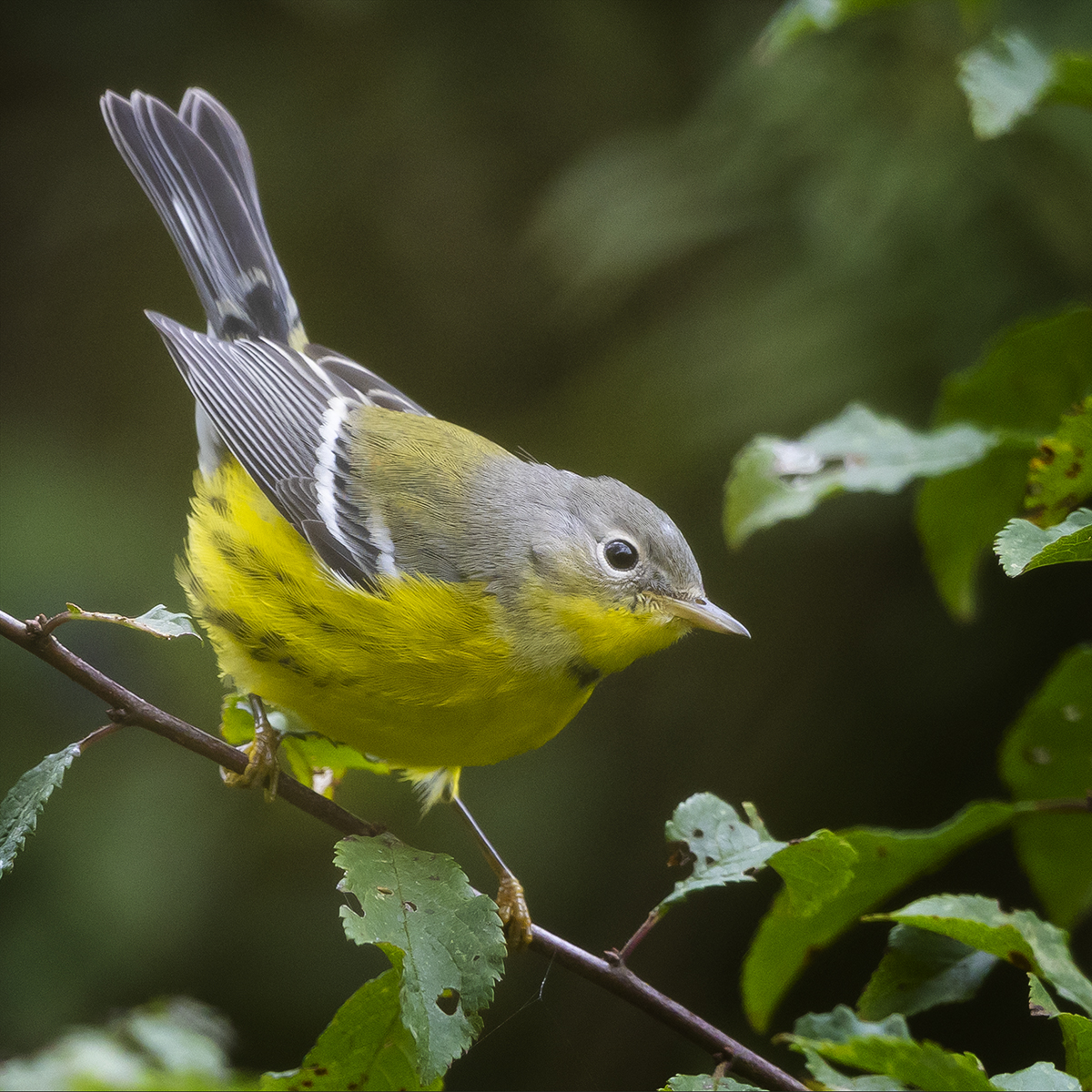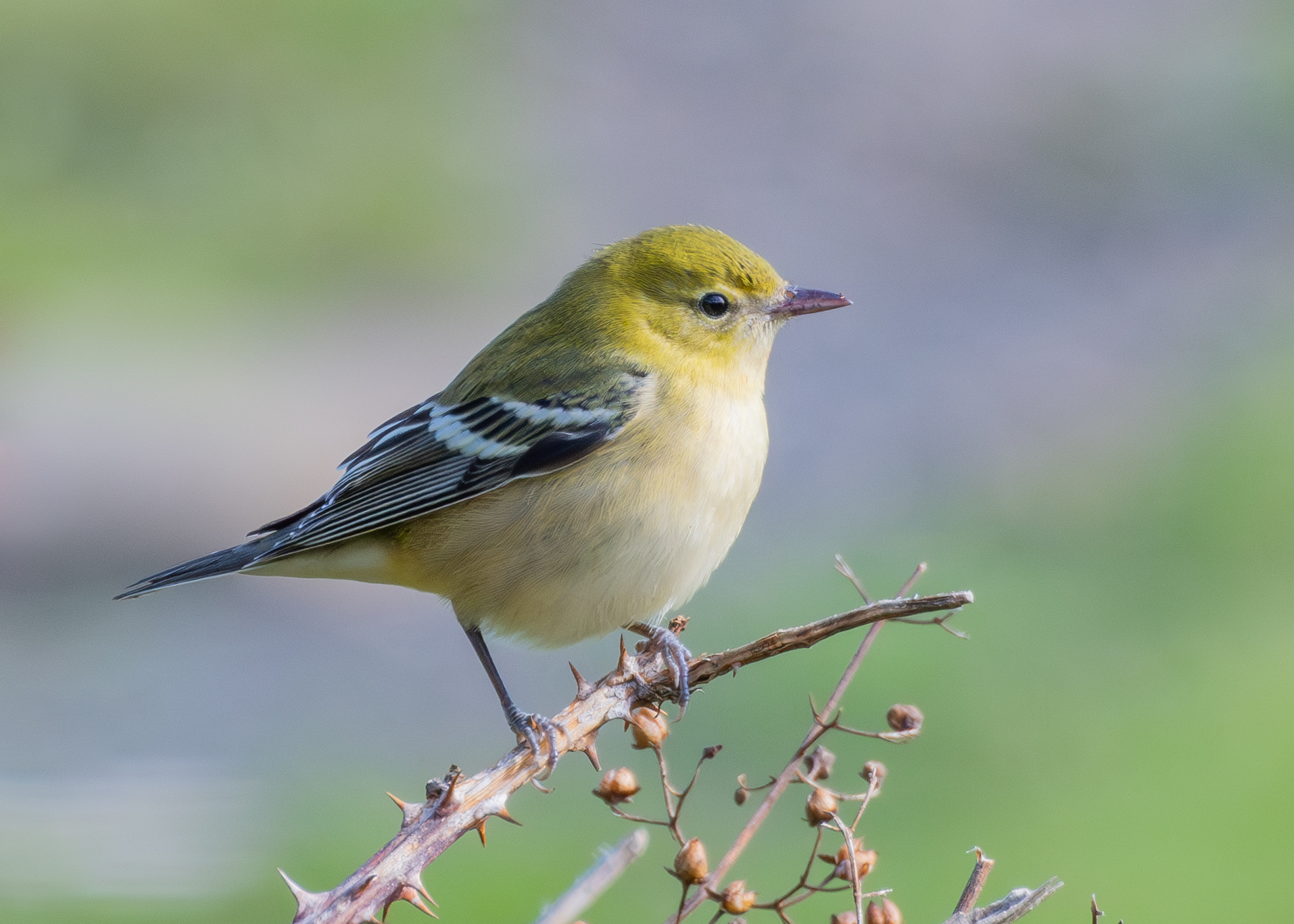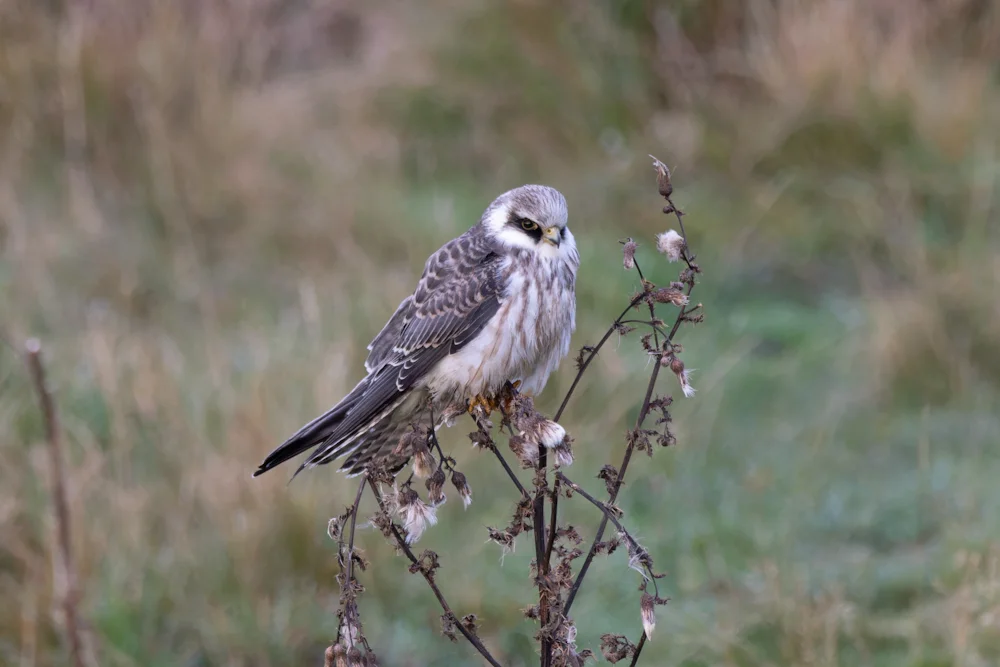Once the dust settles, birders will look back on the past seven days as one of the all-time great birding spells in Britain and Ireland. Simply put, this week has produced the biggest arrival of American landbirds across these isles in recorded history – in excess of 50 individuals of 15 species have been seen since the remnants of Hurricane Lee swept across the Atlantic and crashed into south-western areas on Tuesday. And still, as I pen this article, more and more megas are being found.
Exactly what caused this week's unprecedented fallout of American birds needs further analysis, but it appears that a perfect storm of heavy migration combining with the classic tracking of Hurricane Lee up the eastern seaboard of North America displaced large numbers of birds – see this video from Maine last week – followed by the quick-moving transition of ex-Lee across the Atlantic to Britain and Ireland.
Of course, it's very possible that the hallowed autumn of 1985 might have been similarly good, perhaps even better, if birders had been out looking up the length and breadth of Britain and Ireland back then, rather than being almost solely focused on the Isles of Scilly. But even accounting for a much better spread of coverage along the west coast between the Butt of Lewis and St Agnes these days, there is surely little room for doubt that a single system has ever been this productive.
It's not just the number of birds involved, either – it's the exceptional calibre of rarity that it has produced. This week we've had a first, a second and two thirds for Britain in Pembrokeshire alone, a first and a second for Ireland, a major influx of American Cliff Swallows, flocks of vireos and so much more besides.
The fun started on the afternoon of 19th when an American Cliff Swallow was found at North Foreland, Kent. Although initially assumed to be a bird that must've filtered down from late August's big arrival, with hindsight it seems just as likely to have been the frontrunner to this week's 'Yankmageddon'. Two more followed on 20th, one on Scilly and another at Kilbaha, Co Clare – the latter proved to be the long-awaited first twitchable Irish record and was enjoyed by all the country's top listers. Astonishingly, a further six individuals had been found in Ireland by the end of the week, with a single Welsh bird at Sker Point, Glamorgan, on 22nd.

American Cliff Swallow, North Foreland, Kent (Alex Perry).
It was on the morning of 20th that we received the first hint that something serious was happening. A first-winter male Blackburnian Warbler was found by Brian Power on Skellig Michael, a rock some 12 km off the Iveragh Peninsula in Co Kerry. This was a first for Ireland, no less, and clearly fresh in. What else was Lee about to deliver?

Blackburnian Warbler, Skellig Islands, Kerry (Brian Power).
The answer came that evening. At 6 pm, news broke of an Empidonax flycatcher on Skokholm, Pembrokeshire. Less than an hour later, Britain's third Magnolia Warbler was discovered on the Pembrokeshire mainland at St Govan's Head, its luminous yellow underparts positively glowing in the gathering gloom when it was first glimpsed by Toby Phelps. By this point it was clear that something special was happening, yet few could have expected things to go up another gear the following day.

Magnolia Warbler, St Govan's Head, Pembrokeshire (Will Bowell).
On Thursday 21st, no fewer than nine mega alerts were sounded for American landbirds. The first came at 9.10 am in the form of a Bobolink on Skokholm, where the 'Empid' was still present. Good-quality photos of the latter made a compelling case for it being Britain's third Alder Flycatcher, something which was later reinforced by biometrics when the bird was trapped and ringed.

Bobolink, Skokholm, Pembrokeshire (Skokholm Warden).

Alder Flycatcher, Skokholm, Pembrokeshire (Skokholm Warden).
An hour later, news broke that a Black-and-white Warbler had been trapped on Bardsey Island, Gwynedd – although it disappeared not long after ringing, disappointing would-be twitchers who made the trip across that afternoon. Extraordinarily, a second Black-and-white was trapped on Bardsey two days later on the evening of 23rd, while a third individual of this species was found on Tresco, Scilly, late on 21st.

Black-and-white Warbler, Bardsey Island, Gwynedd (Steven Stansfield).
At 10.54 am, a full 45 minutes after Bardsey's Black-and-white, another Welsh island got in on the action – this time it was Ramsey Island off the St David's Peninsula with Britain's second Bay-breasted Warbler. Gallingly for the big crowds gathered down the road at the Magnolia Warbler twitch, boat crossings weren't possible due to weather conditions and the closest birders could get was to gaze longingly at Ramsey from the mainland – it was even possible to see a gathered crowd on the island watching the bird! Fortunately, the Bay-breasted lingered until Saturday and the RSPB kindly managed a successful twitch to the island during a brief respite in the weather. There was no sign of the bird on Sunday.

Bay-breasted Warbler, Ramsey Island, Pembrokeshire (Tom Hines).
The afternoon of 21st produced further quality finds in the form of a Tennessee Warbler on Barra, Outer Hebrides, and two different Baltimore Orioles on Inishbofin, Galway. A third oriole was then found on Rathlin Island, Co Antrim, early on 22nd, while Inishbofin struck again with Ireland's second Tennessee Warbler later that day. Inishbofin is rapidly establishing itself as Ireland's premier hot-spot for American landbirds and also lays claim to the only previous Irish record of Tennessee in October 2020 – a bird that wasn't twitchable due to COVID-19 lockdown restrictions. This year's bird lingered until the end of the review period and was a very welcome grip-back for all the top Irish listers.

Baltimore Oriole, Inishbofin, Galway (Peter Phillips).

Tennessee Warbler, Inishbofin, Galway (Brian McCloskey).
For obvious reasons, there were plenty of birders in Pembrokeshire on the morning of Saturday 23rd: the Magnolia was still showing and both the Bay-breasted and Alder Flycatcher were being twitched. One can only imagine the pandemonium, then, when Toby Phelps clapped eyes upon Britain's first Canada Warbler only a few kilometres along the coast from where he'd found the Magnolia Warbler some 60 hours previous! It was only 9 am and some birders were already eyeing up a four-tick day in south-west Wales, while Toby had made not one but two finds of a lifetime in the space of a few days.

Canada Warbler, St Govan's Head, Pembrokeshire (James Thorpe).
By this point, it's fair to say that complete and utter bedlam had set in. All sense of reality had been lost. What was next?! We didn't have to wait long to find out. Shortly before 11 am, Britain's second Philadelphia Vireo was identified on Barra, extraordinarily in the company of two Red-eyed Vireos. In fact, we've got this far into the article without even mentioning 'REVs', so it's worth pointing out that a hugely impressive 19 were found – and no fewer than four of these were on Barra! Away from the Scottish hot-spot, most of them (nine) were in south-west England, with five in Ireland including two on Clare Island, Co Mayo, and, strangely, only one in Wales (at Sker Point, Glamorgan).

Philadelphia Vireo, Castlebay, Barra, Outer Hebrides (Bruce Taylor).

Red-eyed Vireo, Clare Island, Mayo (Josh Jones).

Red-eyed Vireo, Sker Point, Glamorgan (Tate Lloyd).
The Philadelphia was quickly followed by several further mega alerts. At 11.35 am, Britain's first Northern Parula since 2010 was found on St Martin's, Scilly, with an Ovenbird on Rum, Highland, at 12.07 pm and the week's second Empidonax flycatcher at Cilan Head, Gwynedd, at 12.46 pm. This last bird was still around the following day, but was proving extremely elusive in challenging weather conditions and a specific identification hasn't yet been suggested.
The carnage continued on 24th, with two new American Cliff Swallows in Co Cork and a frightfully elusive New World warbler species at the unremarkable location of Baglan Energy Park near Port Talbot, Glamorgan. Surreally, this bird transpired to be Wales's second Magnolia Warbler of the week (and only Britain's fourth ever). If birds of this quality are being found in well away from the likely headlands, one has to wonder how much more is out there to be found. No doubt there will be plenty more discoveries throughout the coming week. Finally, news from Barra on the evening of 24th concerned the island's second Tennessee Warbler of the week. The sea change in status of this species is hard to get to grips with – or, perhaps more accurately, it's quite amazing that Britain somehow went 25 years without one and has now had six in four years.
Oddly, given the deluge of American landbirds, it was a fairly subdued week for wader arrivals. A juvenile Baird's Sandpiper at Meols on 20-21st was a welcome find for Wirral birders, while another was found on Tiree, Argyll, on 22nd and the Barra bird reappeared. White-rumped Sandpipers were at Frampton Marsh RSPB, Lincolnshire, and Seafield, Co Clare, while Pectoral Sandpipers were at a very modest 25 sites and Semipalmated Sandpipers at three. Seven Buff-breasted Sandpipers included a new bird in Shetland and two flying in off the sea at the Magnolia Warbler twitch in Pembrokeshire. A juvenile Spotted Sandpiper was at Howth Head, Co Dublin, for a day on 23rd, while at least nine Lesser Yellowlegs was a solid showing. Typically for the time of year, the majority of the week's 10 American Golden Plovers were in the far north and west.

Baird's Sandpiper, Tiree, Argyll (Jim Dickson).

Spotted Sandpiper, Howth Head, Dublin (Josh Jones).

Lesser Yellowlegs, Frampton Marsh RSPB, Lincolnshire (Ian Bollen).
That only 40 British sites between Unst and St Agnes produced Yellow-browed Warbler sightings this week was a good indication that it hasn't been the best September to be birding on the east coast, and there's no suggestion in the forecast that things are going to improve on that front, at least before the arrival of October. Still, three Lanceolated Warblers managed to sneak in (North Ronaldsay, Orkney, scored one on 18th and two made it to Fair Isle, Shetland), as did Pallas's Grasshopper Warblers to Foula and Noss, Shetland. Fair Isle also scored a beautiful male Red-tailed Shrike from 23rd – undoubtedly one of the best-looking rarities to be found this week, despite all the dashing Americans – and a Rustic Bunting, while a Red-throated Pipit was on the Shetland Mainland at Quendale. There was also a scattering of the expected scarcities across the Northern Isles, but those who chose to holiday in Shetland this week can be forgiven for feeling somewhat short-changed.

Red-tailed Shrike, Fair Isle, Shetland (Alex Penn).
In fact, slightly bizarrely given the conditions, it was Ireland that was the place to be if Palearctic vagrants were your thing. A memorable double whammy at Brownstown Head, Co Waterford, concerned both Paddyfield Warbler and Black-headed Bunting only metres apart, giving many Irish birders a two-tick day. The warbler lingered all week, but the bunting wasn't seen beyond 20th. Meanwhile, in Co Cork, an Eastern Olivaceous Warbler was a surprise discovery at Mizen Head on 21st, where the Western Bonelli's Warbler lingered from the previous week. Even more of a surprise was the calling Iberian Chiffchaff on the same headland on 22-23rd – an excellent autumn find and only the second Irish record after a one-day bird in June 2010.
Other new finds this week included a first-winter Eastern Yellow Wagtail at Salthouse, Norfolk, for an hour on 23rd, a brief Squacco Heron at Polgigga, Cornwall, on 18th and a Whiskered Tern at an undisclosed site in Kent. What was presumably the same wide-ranging Pallid Harrier toured Mainland Shetland between Tingwall and Quendale, with another seen twice six days apart at Snettisham, Norfolk, and further mobile birds in Essex and on the Isle of Wight. An interesting-looking juvenile at Insh Marshes RSPB, Highland, transpired to be a Hen × Pallid Harrier. Autumn Red-footed Falcons are a rare prize in Britain, so this week's two were not to be sniffed at. A confiding bird at Eglingham, Northumberland, from 19th was followed by another over South Foreland, Kent, on 23rd.

Whiskered Tern, Cross-at-Hand, Kent (Mark Lopez).

Red-footed Falcon, Eglingham, Northumberland (Tom Tams).
Other scarcities of note this week included Purple Herons in Kent, Cornwall, Lancashire and Co Cork, a first-winter Woodchat Shrike at Marazion, Cornwall, that was a handy pit-stop for Scilly-bound birders, an extremely confiding Red-backed Shrike at Landguard NR, Suffolk, from 21st, a new Red-flanked Bluetail in Shetland on 18th (the East Yorkshire bird was still present to 21st), a dozen Red-breasted Flycatchers and eight Melodious Warblers, the last including a well-twitched bird at St Ann's Head, Pembrokeshire.

Woodchat Shrike, Marazion Marsh RSPB, Cornwall (Martin Webb).
Meanwhile, several long-staying rarities continued to be reported. These included the Double-crested Cormorant in Co Leitrim, the Forster's Tern at Poole Harbour, Dorset, Bonaparte's Gulls in Co Antrim and Co Cork, Stejneger's Scoter and King Eider in Lothian and the Brown Booby at South Gare, Cleveland, while the elusive Black Stork at Frampton Marsh RSPB reappeared after a week's absence from 22nd. Frampton also hosted a Blue-winged Teal on 20-21st; the two in East Yorkshire continued to commute between Tophill Low and Watton nature reserves, while another was reported at Frankfield Loch, Clyde, on 21st.

Brown Booby, South Gare, Cleveland (Lee Johnson).
There was still life in the seawatching season, with three Fea's-type Petrel sightings from Irish headlands and large numbers of Great Shearwaters in south-western areas (such as 2,000 past Lizard Point, Cornwall, on 20th). Excellent numbers of Balearic Shearwaters were seen in south-west England, including an impressive 1,041 past Berry Head, Devon, on 20th, while Sooty Shearwater made its way on to many a coastal patchbirder's year list this week. However, Cory's Shearwater numbers do seem to be dropping off at last. Blustery conditions produced a small influx of Leach's Storm Petrel sightings to Liverpool Bay, with birds passing the Wirral and north-east Welsh coastlines as they reoriented. A handful of storm-blown Grey Phalaropes included popular birds at Farmoor Reservoir, Oxfordshire, West Bromich, West Midlands, and Elton Reservoir, Greater Manchester.
In Warwickshire, the Ferruginous Duck turned up again at Draycote Water, while the week's two Ring-necked Duck were both in Glamorgan. Four new American Wigeon showed up this week, with birds on Inishmore, Co Galway, and at Banks Marsh, Lancs, Kilnsea, East Yorkshire, and Berry Fen, Cambs. Three Scottish sites scored Surf Scoter, with one in Ireland at Brandon Bay, Co Kerry.

Ferruginous Duck, Draycote Water, Warwickshire (Nick Truby).
Western Palearctic
With the same weather system that produced the spoils in Britain and Ireland having passed through the Azores 24 hours previously, it was no surprise to see that Corvo was littered with American landbirds this week. The roll call included Blackburnian, Chestnut-sided, Tennessee and three Black-and-white Warblers, four Ovenbirds, Northern Parula, American Redstart, three Common Yellowthroats, Baltimore Oriole, at least five American Cliff Swallows and multiple Red-eyed Vireos. Elsewhere in the archipelago, a Northern Parula was on Pico and a Short-billed Dowitcher on Terceira. There must be many hundreds of American landbirds across the islands at the moment.
A Red-eyed Vireo on Ouessant on 23rd was the only American passerine in France; however, Belgium scored heavily with its first Black-and-white Warbler at Zeebrugge on 24th. Much further east, a Stilt Sandpiper was photographed near Tallinn, Estonia, on 22nd.
An astonishing 19 South Polar Skuas were logged off the Spanish seawatching mecca of Estaca de Bares, Galicia, over the weekend, with a Zino's Petrel passing there on 19th. Further south, a White-backed Vulture spent two days at Casares, Andalucia, while the American Cliff Swallow continued on Fuerteventura. In Cape Verde, the White-faced Whistling Duck remained on Sal.
Perhaps the most eye-opening record of the week, however, was Georgia's first Three-banded Plover at the Chorokhi Delta near Batumi – comfortably the furthest north this African species has been seen in the region.
- Keep up to date with by-the-minute sightings updates of rarities, migrants and birds in your local area at www.birdguides.com/sightings or via the BirdGuides app. New users are entitled to a one-month free trial.


